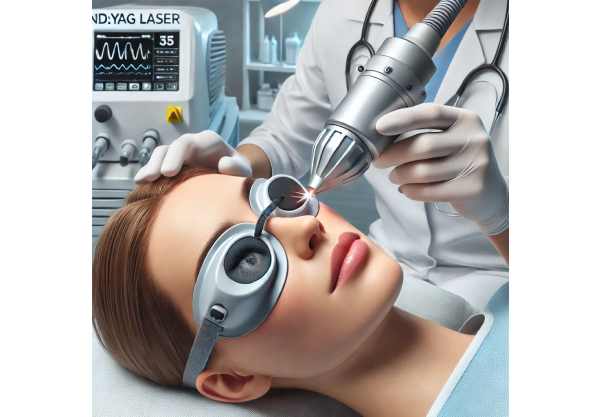
Tuberculosis (TB) of the eye, also known as ocular tuberculosis, is a rare form of Mycobacterium tuberculosis infection that affects primarily the lungs. Ocular tuberculosis can affect multiple parts of the eye, including the conjunctiva, cornea, sclera, uvea, retina, optic nerve, and orbit. This condition can present in a variety of ways, making diagnosis difficult and frequently necessitating a high level of clinical suspicion.
Symptoms of ocular tuberculosis include blurred vision, eye pain, redness, photophobia (light sensitivity), floaters, and, in severe cases, vision loss. Clinical signs include chronic granulomatous uveitis, choroiditis, retinitis, scleritis, optic neuritis, and orbital inflammation. These various presentations may resemble other ocular conditions, complicating the diagnostic process.
The pathogenesis of ocular tuberculosis involves the hematogenous spread of Mycobacterium tuberculosis from a primary site, usually the lungs, into the eye. The bacteria can then cause a local inflammatory response, resulting in tissue damage and disease-specific clinical manifestations. Clinical evaluation, imaging studies such as a chest X-ray or CT scan to identify pulmonary tuberculosis, and laboratory tests such as tuberculin skin test (TST), interferon-gamma release assays (IGRAs), and polymerase chain reaction (PCR) for Mycobacterium tuberculosis DNA are commonly used in the diagnosis.
Early and accurate diagnosis is critical for starting appropriate treatment and avoiding irreversible vision loss and other complications. Treatment strategies for ocular tuberculosis are similar to those for pulmonary tuberculosis, with anti-tubercular medications and adjunctive therapies used to control inflammation and preserve vision.
Standard Treatments for Ocular Tuberculosis
Ocular tuberculosis management and treatment are complex, requiring a multidisciplinary approach involving ophthalmologists, infectious disease specialists, and, in some cases, pulmonologists. The primary goal of treatment is to eliminate the Mycobacterium tuberculosis infection and control the resulting inflammation in order to preserve vision and avoid complications. Anti-tubercular therapy, corticosteroids, and supportive care are all standard treatment options.
Anti-Tubercular Treatment (ATT)
Anti-tubercular therapy is the foundation of treatment for ocular tuberculosis. The standard regimen consists of a combination of first-line anti-tubercular drugs given over an extended period:
- Isoniazid (INH): A bactericidal drug that prevents mycolic acid synthesis in the bacterial cell wall, resulting in cell death.
- Rifampicin (RIF) is another bactericidal agent that inhibits RNA synthesis in Mycobacterium tuberculosis.
- Pyrazinamide (PZA): An important drug in the early intensive phase of treatment, especially in acidic environments like those found in infected tissues.
- Ethambutol (EMB) is a bacteriostatic agent that prevents cell wall synthesis by interfering with arabinogalactan production.
The typical treatment course consists of an intensive phase of two months with all four drugs, followed by a continuation phase of four to seven months with isoniazid and rifampicin. The exact duration of therapy varies depending on the severity of the disease and the patient’s response to treatment.
Corticosteroids
Corticosteroids are used as an adjunctive treatment in ocular tuberculosis to reduce inflammation and prevent tissue damage. These medications help to reduce the immune response caused by the infection, reducing symptoms and complications. Corticosteroids are available in a variety of forms:
- Topical Corticosteroids: Prednisolone acetate eye drops can treat anterior segment inflammation.
- Periocular or Intravitreal Corticosteroids: To treat severe or posterior segment inflammation, corticosteroid injections around or into the eye may be required.
- Systemic Corticosteroids: Corticosteroids can be taken orally or intravenously in cases of severe inflammation or a high risk of vision loss.
Corticosteroids must be used with caution because if not used properly, they can exacerbate infections. It is critical to ensure that adequate anti-tubercular therapy is in place before beginning corticosteroids.
Supportive Care
Supportive care measures are essential for managing symptoms and improving patient comfort:
- Pain Management: Analgesics and anti-inflammatory medications can help alleviate the pain and discomfort caused by ocular tuberculosis.
- Vision Aids: Vision aids and rehabilitation services can help patients with significant vision impairment improve their quality of life.
- Regular Monitoring: Continuous monitoring of visual function, intraocular pressure, and response to treatment is essential for detecting complications early and adjusting therapy as needed.
Latest Advances in Eye Tuberculosis Treatment
Recent advances in ocular tuberculosis treatment have resulted in novel approaches that improve the effectiveness, safety, and convenience of managing this condition. These cutting-edge innovations include novel diagnostic tools, advanced pharmacological agents, and emerging technologies for treatment delivery and monitoring.
PCR and Next-Generation Sequencing (NGS)
Polymerase chain reaction (PCR) and next-generation sequencing (NGS) are powerful molecular diagnostic tools that have greatly improved the accuracy and speed of detecting ocular tuberculosis. PCR detects Mycobacterium tuberculosis DNA in ocular fluids, allowing for rapid and specific identification of the pathogen. NGS, on the other hand, provides a comprehensive analysis of genetic material, allowing the detection of drug-resistant strains and guiding personalized treatment strategies.
- Rapid and Accurate Diagnosis: Compared to traditional culture methods, these molecular techniques shorten the time required for diagnosis, allowing for earlier initiation of appropriate therapy.
- Drug Resistance Detection: NGS can identify mutations associated with drug resistance, allowing anti-tubercular therapy to be tailored and treatment outcomes to improve.
Interferon Gamma Release Assays (IGRAs)
Interferon-gamma release assays (IGRAs) are blood tests that evaluate the immune response to Mycobacterium tuberculosis antigens. Unlike the tuberculin skin test, IGRAs are unaffected by prior BCG vaccination and have a higher specificity for detecting latent tuberculosis. These tests are useful in diagnosing ocular tuberculosis, especially in patients who have unusual symptoms or when other diagnostic methods are inconclusive.
New Tuberculosis Drugs
The development of new anti-tubercular drugs provides promising options for treating drug-resistant tuberculosis and increasing treatment adherence. Examples of new drugs are:
- Bedaquiline: A new drug that inhibits ATP synthase in Mycobacterium tuberculosis, proving effective against multidrug-resistant TB.
- Delamanid: An agent that inhibits mycolic acid synthesis, effective in treating drug-resistant tuberculosis and shortening treatment time.
These new drugs, when combined with traditional anti-tubercular therapy, have the potential to improve treatment efficacy and reduce the burden of drug-resistant TB.
Immunomodulatory Agents
Immunomodulatory agents that alter the immune response are being studied for their ability to improve the efficacy of antitubercular therapy and reduce inflammation. Examples include:
- Interleukin-2 (IL-2): A cytokine that increases immune cell activity and the body’s ability to combat Mycobacterium tuberculosis.
- TNF Inhibitors: Agents that inhibit TNF, thereby reducing inflammation and tissue damage in ocular tuberculosis.
Nanotechnology for Drug Delivery
Nanotechnology provides novel approaches to delivering antitubercular drugs more effectively and with fewer side effects. Nanoparticles can encapsulate drugs and deliver them directly to infected tissues, increasing drug concentration at the site of infection while decreasing systemic toxicity. Examples of nanotechnology-based drug delivery systems are:
- Liposomal Formulations: Liposomes are spherical vesicles that can encapsulate drugs, allowing for precise delivery and controlled release.
- Polymeric Nanoparticles: These nanoparticles can deliver multiple drugs at once, increasing treatment efficacy and patient compliance.
Sustained-release drug delivery systems.
Sustained-release drug delivery systems, such as injectable microspheres and ocular implants, provide extended and controlled release of anti-tubercular medications, reducing the need for frequent administration. These systems can deliver drugs directly to the affected area, which improves therapeutic outcomes and patient adherence. Innovations in this field include the following:
- Intravitreal Implants: Biodegradable implants that release anti-tubercular drugs over several months, allowing for continuous treatment of ocular tuberculosis.
- Microsphere Injections: Medication-encapsulated injectable microspheres with sustained release and targeted delivery to the eye.
Genetic Testing
Advances in genetic testing and personalized medicine open up new possibilities for tailoring treatment strategies to individual patients. Genetic testing can reveal specific genetic mutations or polymorphisms linked to an increased risk of ocular tuberculosis or poor treatment outcomes. This information can help guide the selection of targeted therapies and optimize treatment protocols, resulting in better overall outcomes.
Biomarker Discovery
Biomarkers are measurable indicators of biological processes or therapeutic responses that can help diagnose, monitor, and treat ocular tuberculosis. There is ongoing research to identify novel biomarkers associated with Mycobacterium tuberculosis infection and ocular inflammation. These biomarkers can help researchers understand disease mechanisms, predict treatment outcomes, and guide personalized therapeutic approaches.










